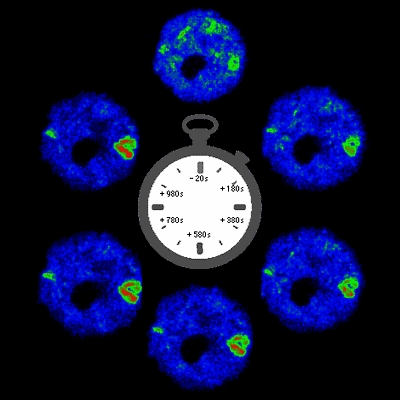Home > Press > Research sheds light on the mechanics of gene transcription
 |
| Watching genes turn on: Multiphoton microscopy images of living cells show the transcriptional activation of heat shock loci in real time. |
Abstract:
The molecular machinery behind gene transcription -- the intricate transfer of information from a segment of DNA to a corresponding strand of messenger RNA -- isn't stationed in special "transcription factories" within a cell nucleus, according to Cornell researchers. Instead, the enzyme RNA polymerase II (Pol II) and other key molecules can assemble at the site of an activated gene, regardless of the gene's position.
Research sheds light on the mechanics of gene transcription
ITHACA, NY | Posted on January 8th, 2008The findings, published in the Dec. 28, 2007, issue of the journal Molecular Cell, are the result of an ongoing collaboration between the laboratories of John T. Lis, the Barbara McClintock Professor of Molecular Biology and Genetics, and Watt W. Webb, professor of applied physics and the S.B. Eckert Professor in Engineering. Jie Yao, the paper's lead author, recently finished his Ph.D. at Cornell under Webb.
Using multiphoton microscopy, a technique developed by Webb that allows high-precision 3D imaging in living cells, the researchers observed polytene chromosomes -- giant, multistranded chromosomes in the salivary gland tissue of fruit flies that have hundreds of sets of the genome instead of the usual two sets in conventional cells.
They activated heat shock genes, which protect cells from sudden rises in temperature, and watched them in real time as they began to be transcribed. The researchers also tagged Pol II with a fluorescent marker to track its movements within the nucleus.
While some reports have suggested that activated genes move to a specific nuclear location for transcription, the Cornell research supports the traditional view that gene activation is not dependent on movement to special locations, or so-called "transcription factories," said Lis.
"You see the genes decondense and fill up with polymerase, but they're not moving anywhere -- they don't collect in a single place," he said. Instead, the transcription machinery assembles at the called-upon locus, regardless of its position in the nucleus.
To test the generality of the findings beyond polytene nuclei to common (but much smaller and more difficult to test) diploid cells, the researchers used a technique called fluorescence in situ hybridization, which allowed them to detect the location of specific DNA sequences along a chromosome in fixed cells.
Looking at the location of co-regulated heat shock genes (genes that are transcribed simultaneously), they found that co-regulated pairs that occupied distinct sites before heat shock were no closer together after heat shock. As in the polytene chromosomes, the genes did not move to a single site for transcription.
And using fluorescence recovery after photobleaching -- another method engineered by Webb -- the researchers found that over time Pol II began to recycle itself within newly formed "compartments" around the activated gene.
"At some point you accumulate enough polymerase that it feeds back, so in a sense you've created a factory de novo" said Lis. "This is, to our knowledge, the first demonstration of Pol II recycling at a specific gene in vivo."
Lis and colleagues are now looking at other molecules involved in transcription to see if they behave similarly. "We're hoping to develop new ways to really see, in vivo, how gene regulation works mechanistically," he said.
####
About Cornell University
The strategic plan for research at Cornell can be summed up simply: Be the best at what we undertake to do. The research enterprise supports university research priorities: the New Life Sciences; cross-college collaborations; and enabling research areas--computing and information sciences, genomics, advanced materials, and nanoscience. We build on our strengths when creating programs, recruiting faculty, purchasing equipment, and supporting interdisciplinary programs. Cornell research is committed to knowledge transfer and engages in technology transfer and economic development activities that benefit local, regional, national, and international constituents.
For more information, please click here
Contacts:
Cornell Chronicle:
Lauren Gold
(607) 255-9736
Media Contact:
Blaine Friedlander
(607) 254-8093
Copyright © Cornell University
If you have a comment, please Contact us.Issuers of news releases, not 7th Wave, Inc. or Nanotechnology Now, are solely responsible for the accuracy of the content.
| Related News Press |
News and information
![]() Researchers develop molecular qubits that communicate at telecom frequencies October 3rd, 2025
Researchers develop molecular qubits that communicate at telecom frequencies October 3rd, 2025
![]() Next-generation quantum communication October 3rd, 2025
Next-generation quantum communication October 3rd, 2025
![]() "Nanoreactor" cage uses visible light for catalytic and ultra-selective cross-cycloadditions October 3rd, 2025
"Nanoreactor" cage uses visible light for catalytic and ultra-selective cross-cycloadditions October 3rd, 2025
Discoveries
![]() Researchers develop molecular qubits that communicate at telecom frequencies October 3rd, 2025
Researchers develop molecular qubits that communicate at telecom frequencies October 3rd, 2025
![]() Next-generation quantum communication October 3rd, 2025
Next-generation quantum communication October 3rd, 2025
![]() "Nanoreactor" cage uses visible light for catalytic and ultra-selective cross-cycloadditions October 3rd, 2025
"Nanoreactor" cage uses visible light for catalytic and ultra-selective cross-cycloadditions October 3rd, 2025
Announcements
![]() Rice membrane extracts lithium from brines with greater speed, less waste October 3rd, 2025
Rice membrane extracts lithium from brines with greater speed, less waste October 3rd, 2025
![]() Researchers develop molecular qubits that communicate at telecom frequencies October 3rd, 2025
Researchers develop molecular qubits that communicate at telecom frequencies October 3rd, 2025
![]() Next-generation quantum communication October 3rd, 2025
Next-generation quantum communication October 3rd, 2025
![]() "Nanoreactor" cage uses visible light for catalytic and ultra-selective cross-cycloadditions October 3rd, 2025
"Nanoreactor" cage uses visible light for catalytic and ultra-selective cross-cycloadditions October 3rd, 2025
|
|
||
|
|
||
| The latest news from around the world, FREE | ||
|
|
||
|
|
||
| Premium Products | ||
|
|
||
|
Only the news you want to read!
Learn More |
||
|
|
||
|
Full-service, expert consulting
Learn More |
||
|
|
||








